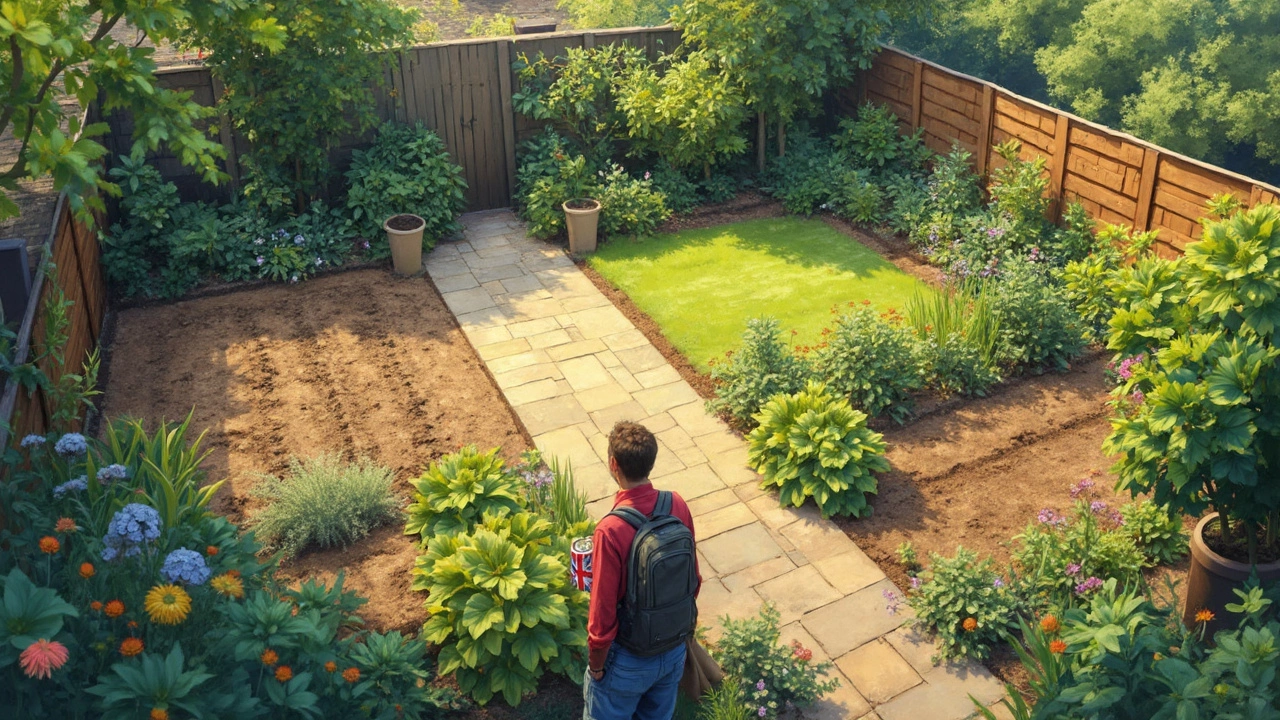Trying to figure out how many times to till before you plant? You're not alone. Most folks think you can just till once and be done, but that's not always the case. Some gardens need a bit more work, while others might be happier if you leave them alone after the first pass.
Tilling isn't just about turning over dirt for the fun of it. It's about making it loose enough for roots to push through and for water to flow. But do it too often, and you can mess up all those good microbes that help your plants grow.
If your soil is super compacted, you might have to go over it two or three times, maybe breaking it up a bit more each time. But if it's pretty loose or was tilled last year, you could get by with one solid session. The trick is paying attention to your soil as you go—crumbling, not clumping? You're probably good.
- Why Till at All?
- One-Time Vs. Multiple Tilling: Which Works?
- Soil Type Can Change Everything
- Signs Your Garden Is Ready
- Tilling Mistakes People Make
- Alternatives to Traditional Tilling
Why Till at All?
So many people ask why you even need to till the garden in the first place. The answer is all about getting your soil ready for a strong start. Tilling isn’t just busywork—it actually helps break up hard, packed ground so plant roots and water can move more easily. It also mixes in organic matter and helps get rid of sneaky weeds before they show up later to steal nutrients.
There are some real reasons to grab that tiller before you plant:
- Loosening soil means your plants don’t have to struggle so much to root deeply. Deep roots = healthier, tougher plants.
- A good till mixes dead leaves, compost, or old mulch right into the dirt. That way, nutrients go straight where roots can reach them.
- Tilling helps air and water get through the ground. This makes it easier for helpful microbes and worms to do their thing.
- You can knock back weed seeds and old roots, which cuts down on future weeding battles.
If you want numbers, a simple test from garden experts shows that plants in well-tilled gardens often grow 20-30% bigger than those in rock-hard beds. That boost alone makes tilling worth a look, especially for new or neglected gardens.
Still, it’s not about tilling just because you’ve always done it. Always check your soil first. If it’s already light and crumbly, you might not need a deep till at all. Save yourself the effort—and your soil’s structure, too.
One-Time Vs. Multiple Tilling: Which Works?
So, should you till your garden soil just once, or go over it a few times? The short answer: it depends on the starting condition of your soil and the kind of garden you want. Some people hear from their neighbors that more passes are always better, but that’s just not true every time.
Let's break it down. If you’re starting with soil that’s been used for gardening before and it breaks up pretty easily with a shovel or tiller, one solid till is likely all you need. This gets rid of weeds, mixes in new compost, and preps a good seedbed for planting. Over-tilling, believe it or not, can actually hurt your soil by breaking down important organic matter and squashing the little critters that make the nutrients your plants crave.
But it’s a different story if your garden spot is hard as a rock, full of thick roots, or has never been tamed before. In that case, a single pass with a tiller usually won’t cut it. You’ll probably need two or sometimes even three passes, ideally spacing them a week or so apart. That gives clumps a chance to dry out and break apart better on the next go. Each pass lets you dig deeper and crush bigger chunks, creating a finer and more even bed for your seeds or seedlings to take off.
Here’s a quick look at what’s usually needed for different situations:
| Soil Type/Condition | Suggested Tilling Passes |
|---|---|
| Loose/previously tilled | 1 |
| Compacted/clay/hard-packed | 2-3 |
| New ground (grass/weeds) | 2-3 |
| Sandy soil | 1 (maybe 2 if it’s packed) |
One thing to remember: whether it’s once or a few times, always keep an eye on moisture. You want the soil kind of crumbly, not sticky or muddy, each time you run your tiller. And watch for earthworms—a bunch of squirmy worms usually means your dirt is healthy and you can chill out on the heavy tilling.
Soil Type Can Change Everything
Here's the thing—your soil isn’t just dirt, and it plays a huge role when deciding how many times you should till. Different types of soil need different game plans, and what works for your neighbor might not work for you at all.
If you’ve got sandy soil, it’s already pretty loose. Over-tilling can actually make it worse by drying it out faster. Once or even skipping tilling (and just mixing compost by hand) could be all you need. But for folks with heavy clay soil? That's another story. Clay clumps and packs down, so you might need to till two or three times, breaking up chunks each time to avoid concrete-like beds.
Loamy soil is the dream—dark, crumbly, and rich. With this type, a single pass with your tiller is often plenty. Tilling more can break down the structure you want to keep. Gardeners with loamy beds usually just lightly turn the top few inches unless there’s some issue like lots of weeds or leftover roots.
| Soil Type | Recommended Tilling | Notes |
|---|---|---|
| Sandy | 0-1 times | Hand mixing is often enough; don’t overdo it. |
| Clay | 2-3 times | Break up chunks slowly, never when it’s wet. |
| Loam | Once | Just fluff it up a little—less is more. |
Pay attention to weather too. Working clay while it’s wet leaves you with rock-hard clods for weeks. With sandy ground, you want a little moisture, so it doesn’t blow away like dust. The big tip? Always grab a handful and squeeze. If it crumbles and doesn’t get stuck to your fingers, it’s ready.
This is why there’s no one-size-fits-all answer for garden soil prep and planting. Check your soil type before you fire up the tiller—seriously, it can save your back and give your plants a huge head start.

Signs Your Garden Is Ready
You might be itching to get your hands in the dirt, but how do you actually know your garden’s good to go after you till? It’s all about noticing a few key signs, so you don’t mess with the soil more than you need to.
Here’s what you want to check before you plant anything:
- Soil breaks apart easily: Grab a handful and squeeze. If it crumbles instead of sticking together in a muddy ball, that’s a green light.
- No big clumps: Clumps mean there’s still work to do. You want a smooth texture so roots don’t have to wrestle for room.
- No standing water: Puddles after rain or watering? Wait. The soil should be moist, not soggy. Too much water means your plants could rot or the tilling could make compacted layers.
- Soil temp over 50°F (10°C): Cold soil can stress out seeds or make them rot. Most garden seeds like a bit of warmth to kick off strong growth.
- Earthworms show up: If you spot a worm or two while digging, give yourself a high five. Worms mean your soil’s alive and healthy after tilling.
You might be wondering how long after tilling you should wait before planting. Ideally, let things settle for a few days, especially if you mixed in compost or fertilizer. This gives the soil time to mellow out so plant roots aren’t shocked.
If you want an extra-clear picture, you can run a simple test known as the “soil squeeze test.” Wet a chunk of soil in your hand and squeeze it. If it falls apart when you poke it, your garden is ready for planting.
| Readiness Sign | What It Means |
|---|---|
| Soil crumbles easily | Ready for planting, roots can move freely |
| No large clumps | Smooth texture, less work for seeds |
| Worms present | Healthy, living soil |
| Moist but not soggy | No risk of compacted layers or rot |
| Soil temp > 50°F (10°C) | Seeds can sprout quickly and safely |
Trust your senses and your gut—it’s not rocket science, and with a little practice, you’ll know right away when your garden is prepped for a killer growing season.
Tilling Mistakes People Make
Plenty of gardeners run into problems by not knowing when to stop with the till. It sounds easy, but there are some common slip-ups that can turn a healthy patch into a headache.
Probably the most frequent mistake is over-tilling. Folks figure that more tilling means better soil, but that's not true. Over-doing it breaks down the soil structure so much that it can end up compacted and less able to hold water—literally the opposite of what you want. The soil preparation is supposed to make things easier, not harder.
Another biggie: tilling when the ground is too wet. If the dirt's sticky and comes up in clumps, you're better off waiting a few days. Wet soil packs down hard, and your planting beds will feel like cement by midsummer. You can check by squeezing a handful; if it stays in a ball and water drips out, hold off a bit longer.
- Tilling too deep: Most garden plants only need loose soil about 8-10 inches down. Going further just wastes energy and brings up weed seeds that have been sleeping near the surface for years.
- Skipping debris removal: Stones, sticks, and roots caught by the tiller can wreck your machine or leave big, airless gaps where plants struggle to grow.
- Forgetting to add organic matter: If you till without mixing in compost or aged manure, you just churn up the same old dirt. Good soil needs those nutrients.
A quick look at what goes wrong if you make these missteps:
| Tilling Mistake | What Happens |
|---|---|
| Over-tilling | Soil compaction, fewer nutrients, poor drainage |
| Tilling when wet | Clumpy beds, roots can't spread, water doesn't flow well |
| Tilling too deep | Brings weed seeds to surface, wastes effort |
Stick to one or two smart passes with the till, check soil moisture, and add some organic stuff each time. That’s how you set up your garden for the best start.
Alternatives to Traditional Tilling
If you're not into firing up the tiller every year, good news—there are other ways to get your garden ready for planting without old-school digging. More gardeners these days are skipping the usual till routine for something gentler on both soil and your back.
No-till gardening means just what it sounds like: you leave the soil alone. Instead of breaking up the dirt, you add layers of compost or mulch right on top. Over time, earthworms and microbes mix everything together for you. This keeps the soil alive and helps lock in moisture, which means less watering and fewer weeds.
- Sheet mulching: You lay cardboard or newspaper straight on weedy spots, then layer it with compost and mulch. Give it a few months, and roots will push right through.
- Broadforking: For those spots that really need loosening, a broadfork can open up the ground without flipping it. This tool lifts and cracks the soil, which helps air and water slip in, but keeps those good soil layers mostly undisturbed.
- Cover crops: Planting things like clover or rye over winter helps fix nutrients, add organic matter, and keep weeds down. When spring arrives, you just cut the crops down and plant right into the mess.
No-till isn’t just a trend. Researchers have found it can actually increase earthworm populations and organic matter. A 2023 Ohio State University study showed gardens that skipped the till had up to 30% more worms in just one year.
"No-till beds build structure and fertility naturally—saving time, energy, and, eventually, money." – Eliot Coleman, author of The New Organic Grower
Traditional till practices break up soil clumps but can also destroy as much as 90% of beneficial fungi with each deep pass. Switching to these alternatives can help your garden thrive over time—no backache required.





